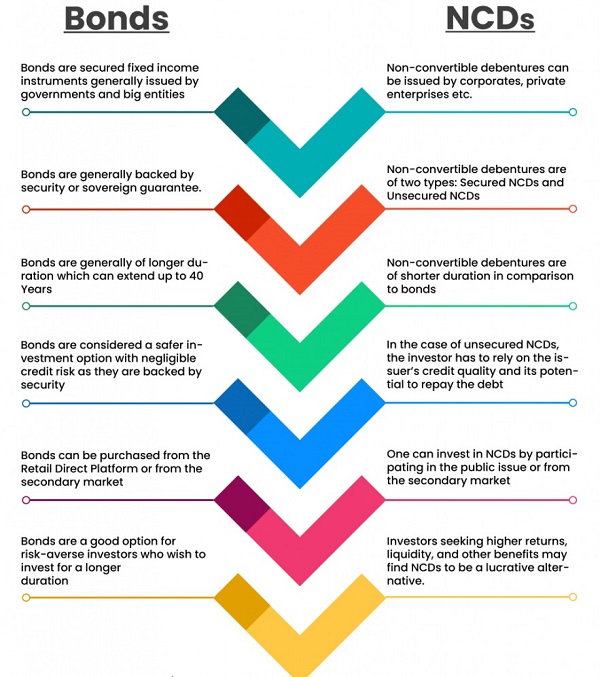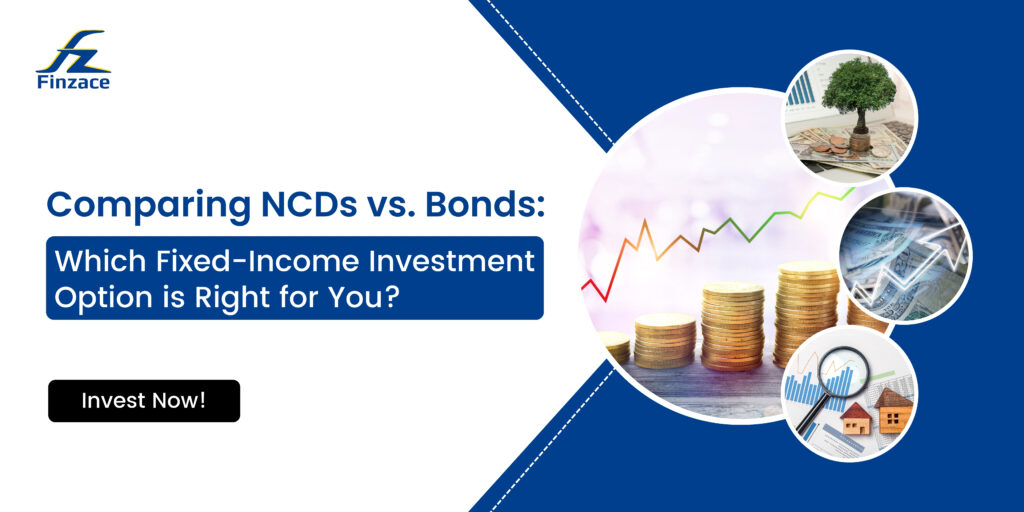In the realm of investments, fixed-income options are renowned for their reliability and stability, providing investors with a dependable stream of income over a specified timeframe. Among the plethora of fixed-income options available, Non-Convertible Debentures (NCDs) and Bonds occupy prominent positions. Both offer appealing returns and are perceived as relatively secure investment avenues. In this comprehensive guide, we aim to explore the intricacies of NCDs and Bonds, conducting a thorough comparison across various parameters.
Understanding NCDs and Bonds:
NCDs, or Non-Convertible Debentures, serve as debt instruments through which corporations raise capital. Unlike convertible debentures, NCDs lack the feature of being converted into equity shares. Investors receive fixed interest payments at regular intervals, usually semi-annually or annually, until the maturity date, when the principal amount is repaid.
Bonds, conversely, represent debt securities issued by governments, municipalities, or corporations for financing projects or ongoing operations. They come with a specified maturity date, at which point the principal amount is returned to the investor. Similar to NCDs, bonds also offer periodic interest payments, referred to as coupon payments, until the maturity date.
Comparing NCDs and Bonds:

1. Risk Profile:
NCDs: NCDs are generally seen as less risky than stocks but aren’t entirely risk-free. The level of risk depends on the issuer’s creditworthiness. Higher-rated NCDs are considered safer, indicating a lower likelihood of default.
Bonds: Government bonds are often viewed as the safest option because they’re backed by the government’s creditworthiness. Corporate bonds carry varying levels of risk depending on the issuer’s financial health and credit rating.
2. Returns:
NCDs: NCDs typically offer higher returns than traditional fixed-income options like bank fixed deposits. Interest rates on NCDs are influenced by market conditions, issuer reputation, and prevailing interest rates. It is generally between 11%-15%
Bonds: Government bonds usually yield lower returns than corporate bonds to compensate for their lower risk. High-yield corporate bonds may offer higher returns but come with increased risk due to the potential for default.
- Liquidity:
NCDs: NCDs are generally less liquid than bonds since they’re traded over-the-counter (OTC) and may have fewer active buyers and sellers. Early redemption of NCDs may also incur penalties.
Bonds: Bonds tend to be more liquid than NCDs, especially government bonds, which are actively traded in the secondary market. Corporate bonds may have lower liquidity, especially for lower-rated issuers.
- Investment Horizon:
NCDs: NCDs suit investors with a medium to long-term investment horizon, typically ranging from 1 to 10 years. They offer flexibility in choosing tenures based on investors’ financial goals.
Bonds: Bonds cater to investors with various investment horizons, offering options ranging from short-term Treasury bills to long-term government and corporate bonds.
- Tax Implications:
NCDs: Interest earned from NCDs is taxable based on the investor’s income tax slab, making them less tax-efficient for high-income individuals.
Bonds: Government bonds, especially tax-free bonds, offer tax benefits since the interest income is exempt from income tax. Corporate bonds are taxed similarly to NCDs.
The Role of Finzace:
In navigating the complex landscape of fixed-income investments, Finzace play a pivotal role. It offers a comprehensive range of investment products, including NCDs, bonds, and other fixed-income instruments, catering to the diverse needs of investors. Through it’s intuitive platform, investors can access a wide array of investment options, compare interest rates, credit ratings, and tenures, empowering them to make informed investment decisions aligned with their financial goals and risk tolerance.
Conclusion:
In conclusion, both NCDs and Bonds offer best fixed-income investment options with varying degrees of risk and return potential. NCDs may be preferred by investors seeking higher returns with moderate risk tolerance, while bonds, especially government bonds, are suitable for investors prioritizing safety and stability. It’s essential for investors to assess their financial goals, risk appetite, and investment horizon before choosing between NCDs and Bonds. Finzace serve as invaluable resources, guiding investors through the intricacies of fixed-income investments and empowering them to build a diversified and resilient investment portfolio. Ultimately, the choice between NCDs and Bonds depends on individual preferences and financial objectives, with both options playing a vital role in achieving long-term financial prosperity.

